╔
Il cous cous ci insegna che l’amore non si ferma, mai!
Pensate ad una spiaggia lunghissima, di morbida sabbia rosa finissima e luccicante, punteggiata sul bagnasciuga dal rosso di minuscoli coralli gentilmente erosi dai fondali dal lento movimento delle onde, abitata da palme che si protendono verso un mare cristallino che sfuma dall’azzurro chiarissimo al verde smeraldo al blu cobalto …
La vostra immaginazione vi sta portando, molto probabilmente, su una spiaggia di Antigua o delle Bahamas …
Noi, invece, vi porteremo in Sicilia, nella spiaggia “caraibica” raccolta attorno al golfo di San Vito Lo Capo, in una località tanto remota e inaccessibile quanto paradisiaca.
Imagine a very long beach, made of soft fine sparkling pink-tinged sand, with a shore tinted by tiny red corals gently erased by the slow movement of waves, enriched by palm trees protruding towards a crystal-clear blue water, characterized by magic shades from pale azure into deep cobalt blue.
Your imagination is surely taking you to a beach in Antigua or to the Bahamas…
Well, actually we are going to take you to Sicily, and precisely to the “Caribbean” beach of the gulf of San Vito Lo Capo, a remote and inaccessible, yet extremely heavenly, location!
Le origini delle tradizioni culinarie di San Vito Lo Capo
The origins of culinary traditions of San Vito Lo Capo
A San Vito Lo Capo, posto su una lingua di terra protesa sul mare nella costa occidentale della Sicilia, viveva una piccola comunità di pescatori che dava ospitalità ai fedeli che si recavano in pellegrinaggio al santuario del Santo. Difficilmente accessibile via terra, questo lembo di paradiso terrestre ha vissuto isolato dal resto del mondo, in stretta simbiosi con il mare.
Per secoli il mare ha rappresentato la principale fonte di sostentamento degli abitanti: i “culammoddo” (letteralmente “culo in ammollo”, così venivano chiamati i pescatori sanvitesi) pescavano cernie, saraghi, ricciole, ombrine e dentici che popolano copiosamente le acque del golfo, e le donne si adoperavano per valorizzare al massimo il pescato. Mentre i pesci più pregiati venivano avviati al commercio, i residui di paranza e i pesci più piccoli hanno dato vita ad una originale tradizione gastronomica che, nel tempo, ha conquistato il palato di un pubblico sempre più vasto.
Dall’incontro tra le scarse risorse agricole di un territorio avaro e dagli scarti del pescato sono nate ricette straordinarie come la calamarata verde con bottarga (anelli di pasta con pesto di basilico e uova di tonno) e le busiate al pesto trapanese (formato di pasta ricavato dall’attorcigliamento dell’impasto su un ramo di buso – il fusto dell’ampelodesmo –, condito con un pesto di aglio, mandorle, pomodori, basilico, pecorino, olio, sale e pepe e guarnito con melanzane e patate fritte). Numerosissime sono le fantasiose elaborazioni che i sanvitesi sono riusciti a creare con gli ingredienti poveri a disposizione, ma il piatto che è riuscito ad esaltare al meglio il loro connubio è, in assoluto, il cous cous di pesce!
In San Vito Lo Capo, located on a stretch of sand leaning on the sea in the north west coast of Sicily, there was a small community of fishermen that used to offer shelter to the peregrines heading to the nearby sanctuary. Being scarcely accessible by land, this piece of earthly heaven evolved isolated from the rest of the world, in tight symbiosis with the sea.
For decades, the sea represented the primary source of maintenance for locals: the “culammoddo” (literally, “ass in the water”, nickname of local fishermen) fished groupers, seabreams, amberjacks, croaker umbrines and snappers that were very abundant in the gulf waters; women were very active in adding value to the catch of the day. While the most prestigious fish was shipped off for trading, residual small fish gave rise to original culinary traditions which, with time, became more and more popular.
From the fusion between poor agricultural resources of a stingy territory and the leftovers of the catch of the day, extraordinary recipes originated, such as the green “calamarata” with “bottarga” (ring-shaped pasta with basil pesto and tuna eggs) or the “busiate” with “pesto trapanese” (a shape of pasta obtained by swirling the pasta dough around a branch of “buso” – which is the stem of the bunchgrass Ampelodesmos – garnished with garlic pesto, almonds, tomatoes, basil, goat cheese, oil, salt, pepper and topped off with fried aubergines and potatoes). Many are the recipes that the inhabitants of San Vito Lo Capo (also referred to as Sanvitesi) were capable of inventing starting from the poor available ingredients, but the dish that mostly exalted this combination is, by far, fish cous cous!
Le origini africane del cous cous
The African origins of cous cous
Questa ricetta nasce dal virtuoso innesto tra la trazione berbera e maghrebina del cous cous e quella siciliana della cucina a base di pesce. Il cous cous ha conosciuto un’ampia diffusione in tutti i paesi del Nord Africa e del Maghreb perché rappresenta una fonte di sostentamento economica, a lunga conservazione e di facile trasporto, ideale per una popolazione che praticava il nomadismo e la pastorizia. Per garantire la conservazione dei cereali il più a lungo possibile, i chicchi venivano frantumanti grossolanamente, appallottolati a mano con l’aggiunta di qualche spruzzo di acqua, setacciati e infine lasciati essiccare.
The recipe originates from the virtuous grafting of the Berber and Maghreb cous cous tradition into the Sicilian cooking based on fish. Cous cous is widely used in all countries in North Africa and Maghreb because represents an economic food source, with a long shelf life and easy to transport, ideal for nomad populations living on farming. In order to guarantee cereals preservation as long and possible, grains were roughly grounded, made in a shape of ball by hand by adding few drops of water, strained and finally left to dehydrate.
Processo di lavorazione del cous cous. (© Santo Graziano).
Process of cous cous making. (© Santo Graziano).
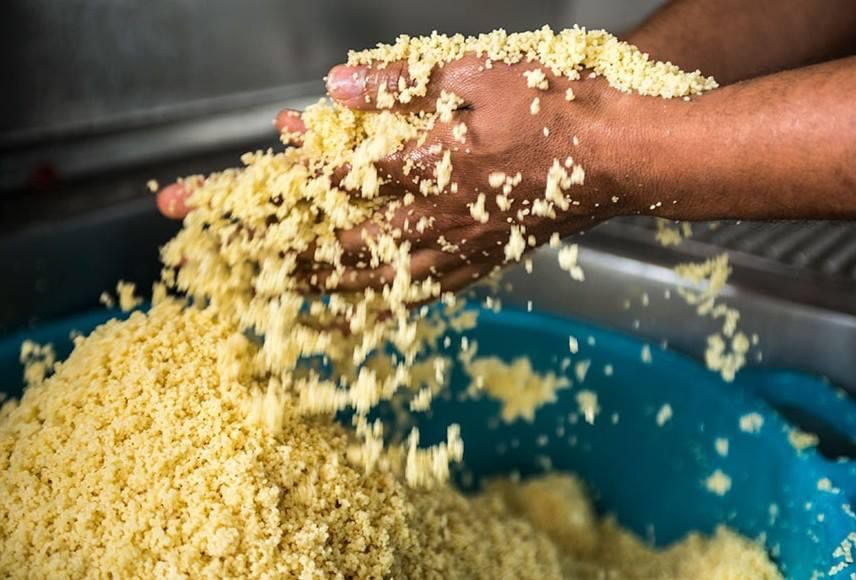
Una volta trattati con questo processo, i cereali potevano essere conservati a lungo e successivamente utilizzati come base per la cottura di numerose varietà di preparazioni, per lo più a base di carne (pollo, agnello, montone), di verdure (ceci, melanzane, patate, rape) e salse piccanti (harissa).
Il cous cous è un cibo sociale, ancor più che un alimento: è diventato un simbolo di pace e amore come piatto principe nella celebrazione dei più importanti riti popolari; di integrazione per la sua versatilità ad accostarsi ad ogni tipo di ingrediente; di condivisione e unione per la convivialità del suo consumo in banchetti collettivi dove ogni commensale attinge da un unico grande piatto la sua porzione direttamente con le mani.
This process guaranteed long term conservation of cereals, that could be used at a later moment as common starting base for cooking many different dishes, mainly containing meats (chicken, lamb, ram), vegetables (chickpeas, aubergines, potatoes, beets) and spicy sauces (harissa).
Cous cous is intended more as a social food, rather than just feeding stuff: it has turned into a symbol of peace and love as a main dish in the most important popular celebrations; a symbol of integration due to its versatility in accompanying any kind of ingredient; a symbol of sharing and union due to the way commensal eat by picking it directly with bare hands from one big platter placed in the middle of a table.
Il cous cous di pesce alla sanvitese
Fish cous cous of San Vito
Giunto in Sicilia a partire dalla dominazione araba e diffuso dai pescatori siciliani che intrattenevano relazioni commerciali con le popolazioni del Nord Africa, il cous cous ha incontrato un nuovo compagno di viaggio: il pesce.
La preparazione del cous cous in Sicilia ricalca la tradizione africana di “incocciare” (appallottolare) a mano il grano duro macinato (semola) in un ampio recipiente (“mafaradda”) con l’aiuto di qualche goccia di acqua. La variante sanvitese prevede di aromatizzare il cous cous “incocciato” con alloro, cipolla, aglio, peperoncino, prezzemolo, mandorle, chiodi di garofano e pepe.
Brought to Sicily by the Arabic domination and spread by Sicilian fishermen that had trading affairs with the populations of North Africa, cous cous had its first liaison with a new travel companion: fish.
The process of cous cous preparation was inherited by the African tradition of “incocciare” (make balls) with bare hands wholemeal in a big container (“mafaradda”) with a few drops of water. The variation typical of San Vito adds bay leaves, onions, garlic, chili, parsley, almonds, cloves and pepper. Thus, this seasoned cous cous is steamed in a special pot called “couscoussiera”, which has holes on the bottom.
Recipiente in terracotta forato sul fondo per la cottura del cous cous. (© Santo Graziano).
Bottom-holed earthenware used for cous cous cooking. (© Santo Graziano).
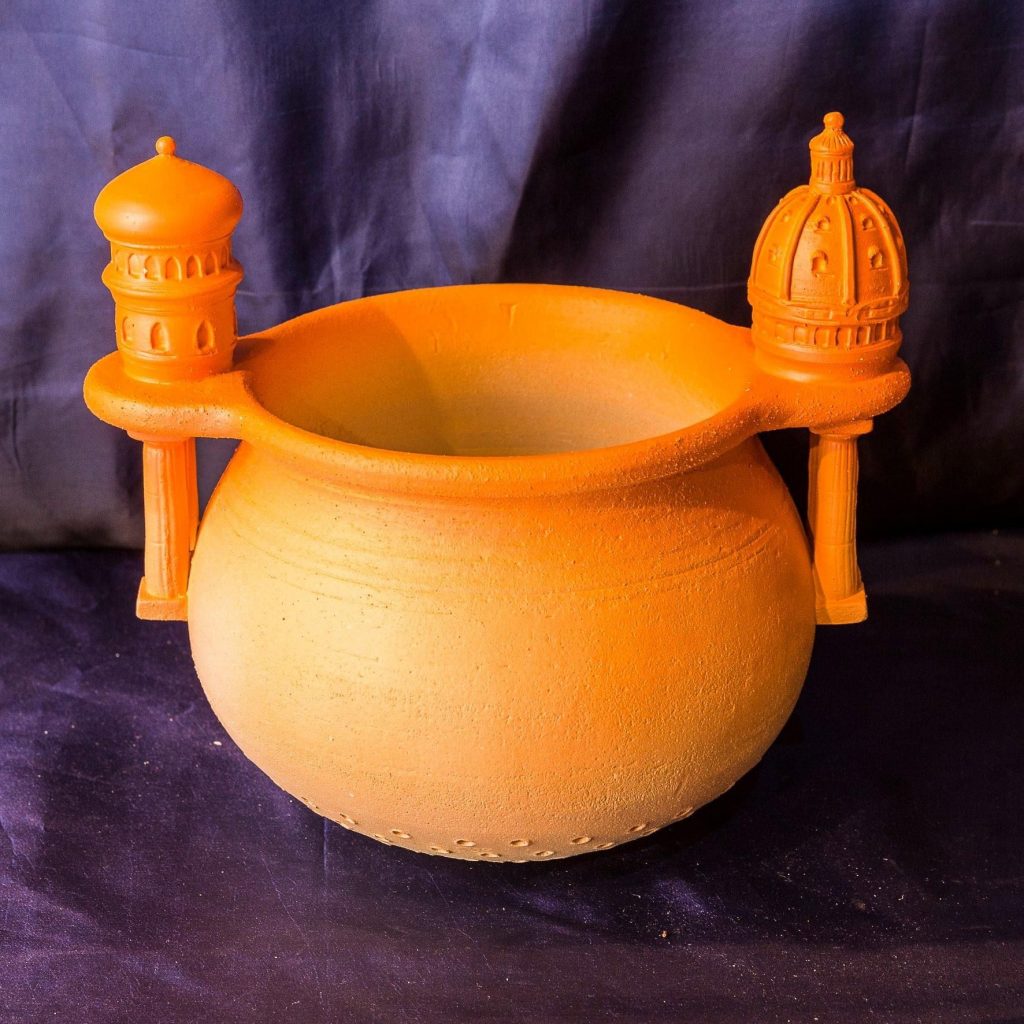
Così aromatizzato, il cous cous viene cotto a vapore in una speciale pentola, la “couscoussiera”, costituita da un tegame con fondo forato, destinato ad accogliere il cous cous, disposto sopra un recipiente nel quale viene portato a bollore un brodo aromatizzato con scorze di limone, pepe in grani e chiodi di garofano. Per una perfetta riuscita della preparazione, è indispensabile che le due pentole siano sigillate tra loro con un impasto di acqua e farina e che la cottura non sia inferiore alle due ore e mezza.
Dopo la cottura a vapore, quando il cous cous è diventato soffice e voluminoso, è tempo di lasciarlo riposare per bene (dalle quattro alle cinque ore) insieme ad un brodo di pesce. Una volta assorbito il brodo, il cous cous è pronto per essere servito su un grande piatto da portata, unitamente alla polpa diliscata dei pesci che hanno preso parte alla cottura del brodo (gallinelle, scorfani, tracine, triglie, cipollette) e al restante brodo.
Cous cous is placed in this pot, which is then put on top of another pottery containing boiling broth seasoned with lemon peels, peppercorn and cloves. To make sure to achieve the best cooking result, it is necessary to seal the two pots using a paste made of water and flour. Equally important, cooking time cannot be less than two hours.
After steaming, when cous cous has acquired softness and volume, it is important to let it sit (between four and five hours) in a fish broth. When all broth has been adsorbed, the cous cous is ready to be served on a big platter, alongside with the flesh of the same fish used to make the broth, completed with some additional broth.
Donna sanvitese durante la preparazione del cous cous. (© Santo Graziano).
“Sanvitese” lady caught during the process of cous cous preparation. (© Santo Graziano).
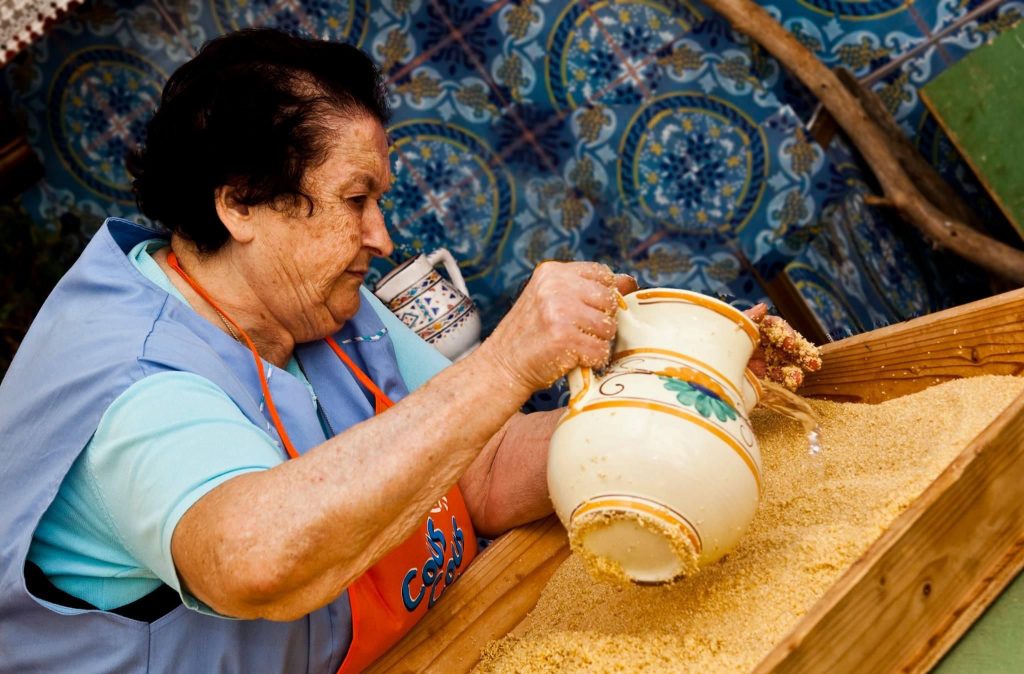
La preparazione del cous cous di pesce è molto lunga e solitamente impiega un’intera giornata. Alle fasi di lavorazione partecipano diverse persone che, lavorando insieme, trovano l’occasione per rinsaldare i loro rapporti sociali. Come le donne di San Vito Lo Capo che ogni anno, sul finir di settembre, finita la frenesia della stagione balneare, si davano appuntamento nel vicolo Venza per incocciare tutte insieme la semola e preparare il cous cous per tutta la comunità sanvitese.
The process of fish cous cous making is very long, usually taking a full working day. Many are the people involved, finding an occasion to bond social relationships during this process that becomes an opportunity of teambuilding. Tradition narrates that every year, at the end of September, after the frenzy of the summertime season, Sanvitesi women gathered all together in Vicolo Venza to prepare cous cous for the entire community of San Vito.
San Vito Cous Cous Fest: Love never stops!
San Vito Cous Cous Fest: Love never stops!
Alla fine degli anni ’90 venne presa l’iniziativa di condividere questa antica tradizione locale con un pubblico più vasto attraverso la promozione di un evento culinario. Nasce così nel 1998 il San Vito Cous Cous Fest, una tradizione che si rinnova ogni anno (nel 2022 festeggia i suoi primi 25 anni) ed è cresciuta nel tempo fino a coinvolgere un pubblico di più di 80.000 persone provenienti da tutto il mondo.
Il festival celebra l’integrazione culturale e la fratellanza tra i popoli, dando il benvenuto alle diversità attraverso la valorizzazione di un ingrediente umile ma estremamente diffuso, che accomuna popolazioni di religioni, credenze e tradizioni differenti. L’anima della festa (a cui fanno da contorno sempre più numerose attività, tra cui appuntamenti culturali, concerti, spettacoli e live show) sono le competizioni culinarie in cui chef stellati e cuochi dilettanti, provenienti da ogni parte del mondo, si sfidano con le loro diverse interpretazioni del cous cous, preparato in base agli ingredienti e alle tradizioni delle rispettive regioni di provenienza.
By the end of the Nineties, this antique local tradition was shared with a wider public thus promoting a social culinary event. In 1998, the San Vito Cous Cous Fest debuts and is repeated on a yearly basis, celebrating in 2022 its first 25 years. This traditional event has expanded every year, involving today more than 80.000 attendees from all over the world.
The festival celebrates cultural integration and brotherhood among populations, welcoming diversities through the exaltation of a humble but extremely popular ingredient, capable of blending populations of religions, beliefs and different traditions. The soul of the festival (which is enriched by many satellite activities among which cultural events, concerts and live shows), are the cooking battles. Here, starred-chefs as well as amateur cooks, coming from all over the world, compete presenting their own personal twists on cous cous, prepared using local ingredients and adding a personal touch inspired by their country of origin.
Da sinistra a destra: Locandina della prima edizione del San Vito Cous Cous Fest, 1998. Preparazione del cous cous durante la prima edizione del festival. (© Santo Graziano).
From left to right: Poster of the first edition of San Vito Cous Cous Fest, 1998. Preparation of couscous during the first edition of the festival. (© Santo Graziano).
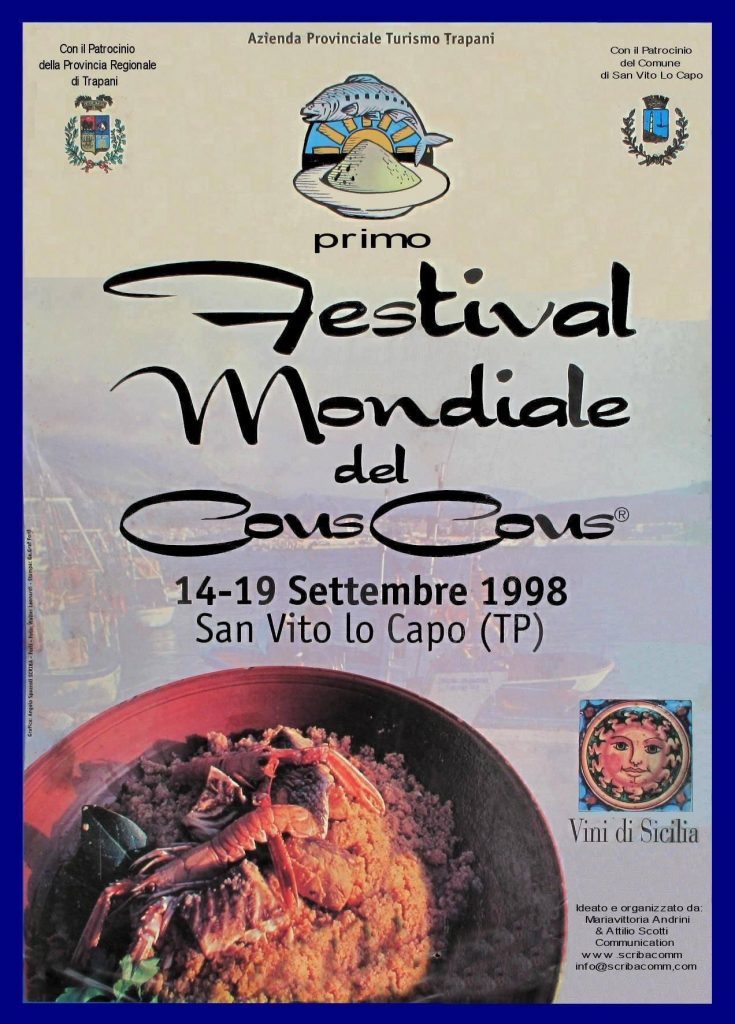
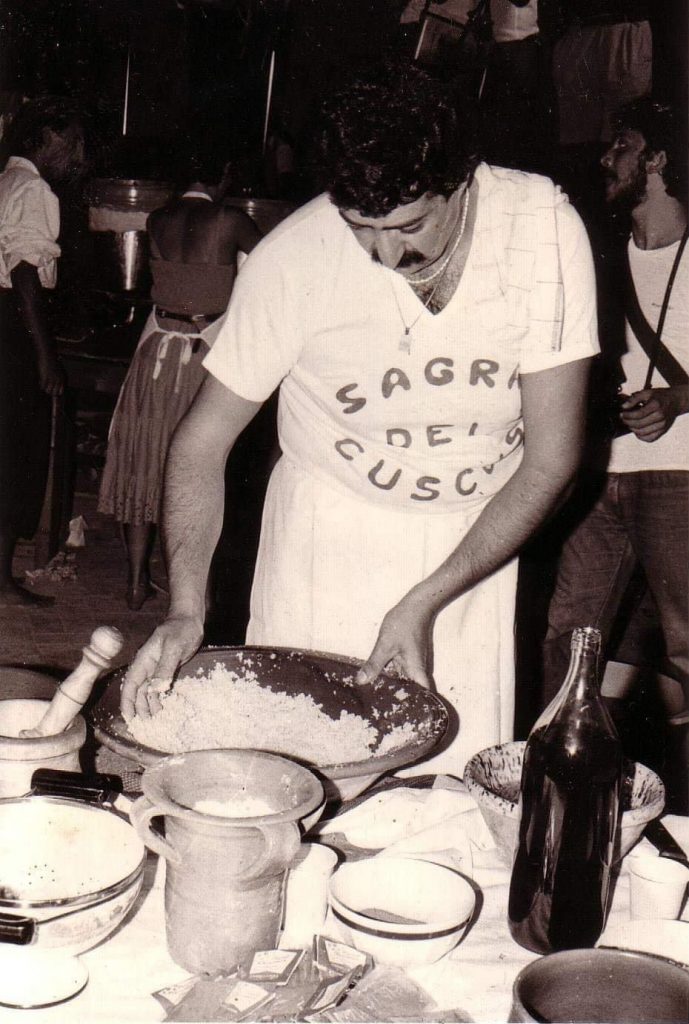
Cerimonia di premiazione del San Vito Cous Cous Fest, edizione 2017. (© Santo Graziano).
San Vito Cous Cous Fest awards ceremony, 2017 edition. (© Santo Graziano).
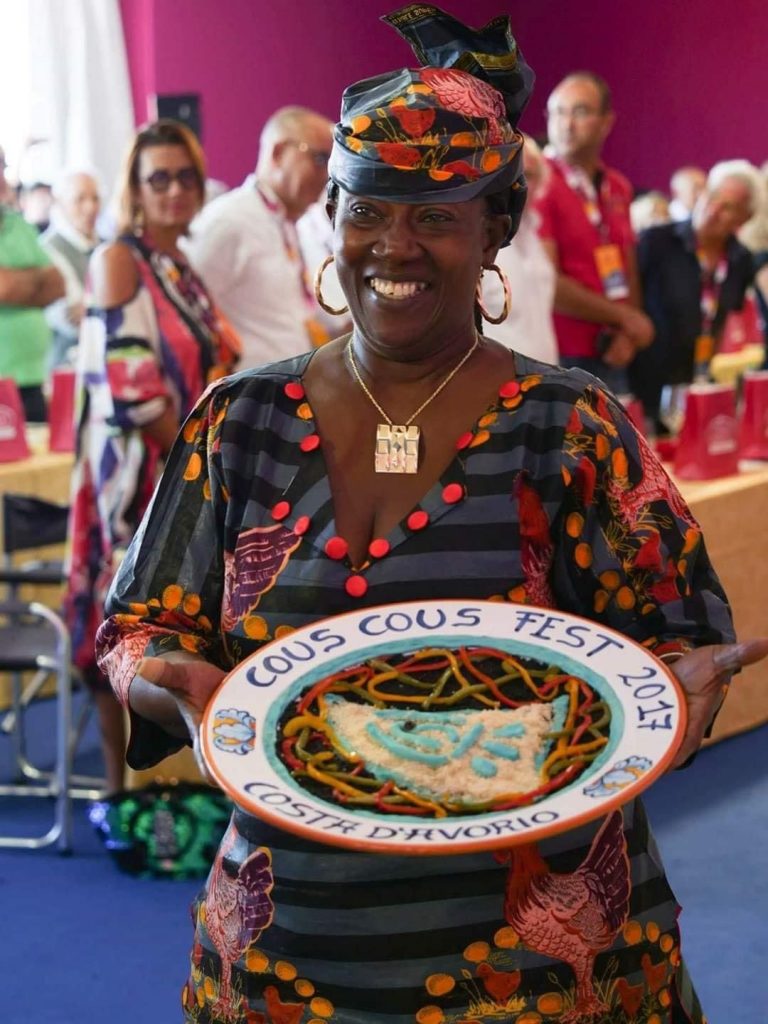
Case del cous cous al San Vito Cous Cous Fest. Negli stand, aperti al pubblico, cuochi professionisti e dilettanti provenienti da ogni parte del mondo eseguono tutte le fasi di lavorazione del cous cous, fino a offrire la degustazione del piatto finito. (© Santo Graziano).
Cous cous houses at the San Vito Cous Cous Fest. In the stands, open to the public, professional and amateur chefs from all over the world carry out all the processing phases of the cous cous, up to offering the tasting of the finished dish. (© Santo Graziano).
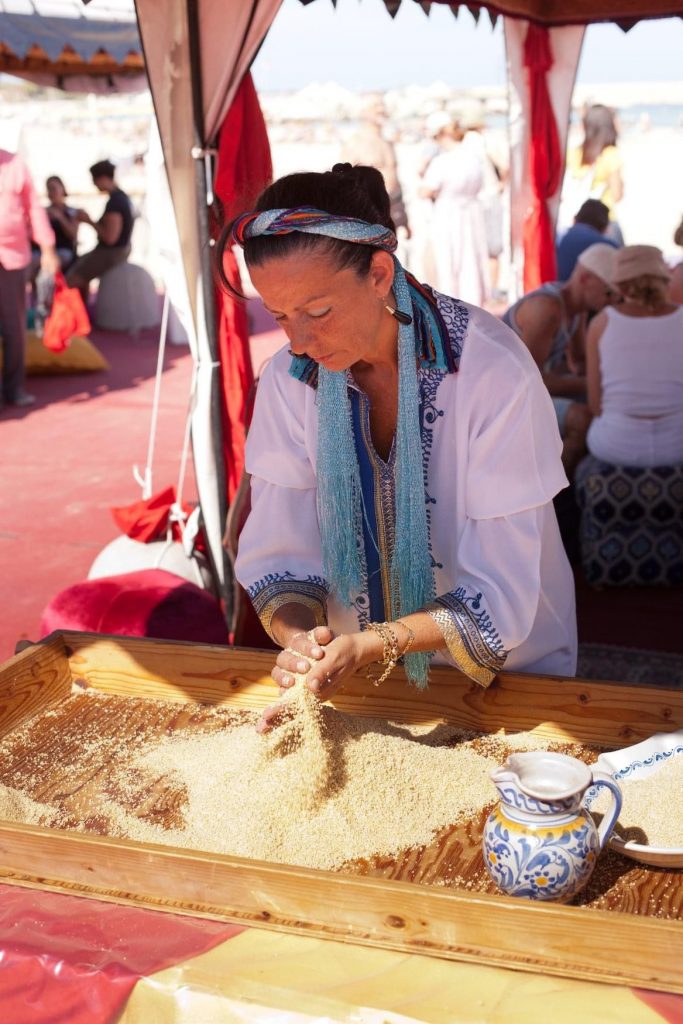

Il crescente successo del festival ha traghettato San Vito da remoto eremo di pellegrinaggio a nuovo luogo-mondo, dispiegandone una dimensione cosmopolita che è testimonianza vivente dell’esigenza espressa dalle comunità di tutto il mondo di un futuro di pace e fratellanza, di condivisione e mutua cura, di scambio e arricchimento reciproco. In una parola: di amore.
Ed è per questo che il motto della venticinquesima edizione, che riassume ed esprime con straordinaria efficacia questa esigenza condivisa, è “Love never stops”!
The emerging and increasing success of the festival has transformed San Vito from an isolated and remote sanctuary for peregrines into a new place/world, unexpectedly unveiling a cosmopolitan dimension. This expression is a living witness of the need of different communities, representing the entire world, for a future of peace and brotherhood, of sharing and mutual care, of exchanging and reciprocal enrichment. In one word: of love.
And for this reason, the motto of the 25th edition, summarizing and expressing with extraordinary efficacy this shared need, is “Love never stops”!
English translation by Ester Badami
IMMAGINE INIZIALE | Spiaggia di San Vito Lo Capo, Trapani. (© Vito La Sala).
HEAD IMAGE | San Vito Lo Capo beach, Trapani. (© Vito La Sala).
╝
Ringraziamenti
Acknowledgment
Si ringrazia Mihaela Cardinale, urbanista e sanvitese di adozione, per le informazioni sul San Vito Cous Cous Fest e i contatti con i fotografi.
Si ringraziano i fotografi Vito La Sala e Santo Graziano per le fotografie che illustrano questo numero della rubrica.
Thanks to Mihaela Cardinale, urban planner and San Vito by adoption, for information on the San Vito Cous Cous Fest and contacts with photographers.
We thank the photographers Vito La Sala and Santo Graziano for the photographs illustrating this issue of the column.